Are you trying to choose between LED and halogen lights for your home or office? There are a lot of options, which can make it hard. Lighting technology has come a long way, and it’s important to know the differences between these two.
There are some things that are different about LED and halogen lights. LEDs are becoming more popular, even though halogen lights have been around for a while. They use less energy and last longer. But which one is best for you?
We’ll talk about how LED and halogen lights work, what they are good for, and how to use them. This guide will help you choose the best lighting for your room.
Key Takeaways
- Learn about the main differences between LED and halogen lights.
- Find out how long each lighting option will last and how much energy it uses.
- Learn about the pros and cons of LED and halogen lights.
- Find out how LED and halogen lights can be used in different ways.
- Find out how to choose the best lighting technology for your needs.
Getting to know lighting technologies
Over time, artificial lighting has changed a lot. We now have LED lights, halogen lights, and others. These changes give both homes and businesses a lot of options.
The Shifts in Artificial Lighting
There have been big improvements in artificial lighting. We have switched from old-fashioned incandescent bulbs to new LED lights. Every step has made the lights use less energy and work better. People liked halogen lights because they were brighter than old bulbs.
“The development of new lighting technologies has been driven by the need for energy efficiency and sustainability.”
Expert in the Lighting Business
How to Choose the Right Light Source
Choosing the right light is important for both saving energy and getting good light. LED lights are great for many things because they last a long time and use less energy. People often choose halogen lights for tasks and outside because they give off a bright white light.
| Lighting Technology | Energy Efficiency | Lifespan |
|---|---|---|
| LED Lights | High | Long (up to 50,000 hours) |
| Halogen Lights | Moderate | Shorter (around 2,000 hours) |
What Are Lights That Use Halogen?
Halogen bulbs are a kind of light bulb that uses incandescent light. They shine by using a tungsten filament and halogen gas. They became popular in the 1960s because of their warm glow.
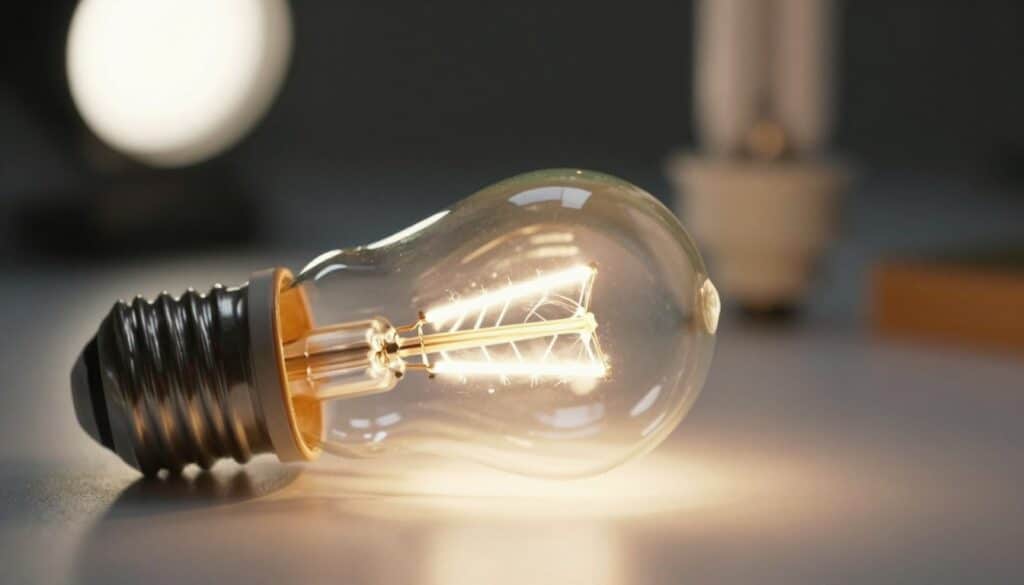
The Science of Halogen Bulbs
Halogen bulbs work on a simple but effective idea. The quartz capsule that holds the tungsten filament is filled with halogen gas.
How Halogen Lights Make Light
The tungsten filament gets hot and glows when electricity flows through it. This makes light. The halogen gas makes the filament last longer.
Parts of a Halogen Lamp
A halogen lamp has a quartz envelope, a tungsten filament, and halogen gas. When you put them together, they make a bright white light.
| Component | Function |
|---|---|
| Tungsten Filament | Produces light when heated |
| Halogen Gas | Extends filament lifespan |
| Quartz Envelope | Contains the filament and gas |
The Evolution of Halogen Lighting
Halogen lights first came out in the 1960s, and they were a big improvement over old incandescent bulbs. As time goes on, technological advances have made halogen bulbs last longer and use less energy.
Halogen bulbs last longer and use less energy thanks to better materials and designs. This has been a big part of their growth.
What are LED lights?
LED lights, which stand for Light-Emitting Diodes, use semiconductor technology to shine. They work better and last longer than older ways of lighting.
The Science Behind Light-Emitting Diodes
Electroluminescence is how LEDs work. A semiconductor makes photons by letting an electric current flow through it. This makes light.
An Explanation of Semiconductor Technology
Silicon and other semiconductors are in the middle of conductors and insulators. They control the flow of electricity. This is very important for LED lights.
How LEDs Make Light
An LED gets its electrons excited by an electric current. This causes them to let out photons. This is called recombination by radiation. This is how LEDs work.
The Rise of LED Technology
LED technology has come a long way. It is now more useful, less expensive, and used in many places. LEDs are in homes, cars, and factories because they last a long time and use less power.
LEDs are getting better all the time. Scientists are working hard to make them work better and find new ways to use them.
The Main Differences Between LED and Halogen Lights
We need to look at how LED and halogen lights work and how they look to see what the main differences are. We can pick the right lighting for our needs if we know these things.
Comparison of Working Principles
Electroluminescence is what makes LED lights work. A special material lets electricity flow through it, which makes light. This way doesn’t make a lot of heat. Halogen lights, on the other hand, use incandescent light. A filament gets hot enough to glow, which makes light. The halogen gas in the bulb keeps the filament from burning out too quickly.
LEDs are more efficient because they turn more of the electricity into light. However, halogen bulbs waste a lot of energy as heat.
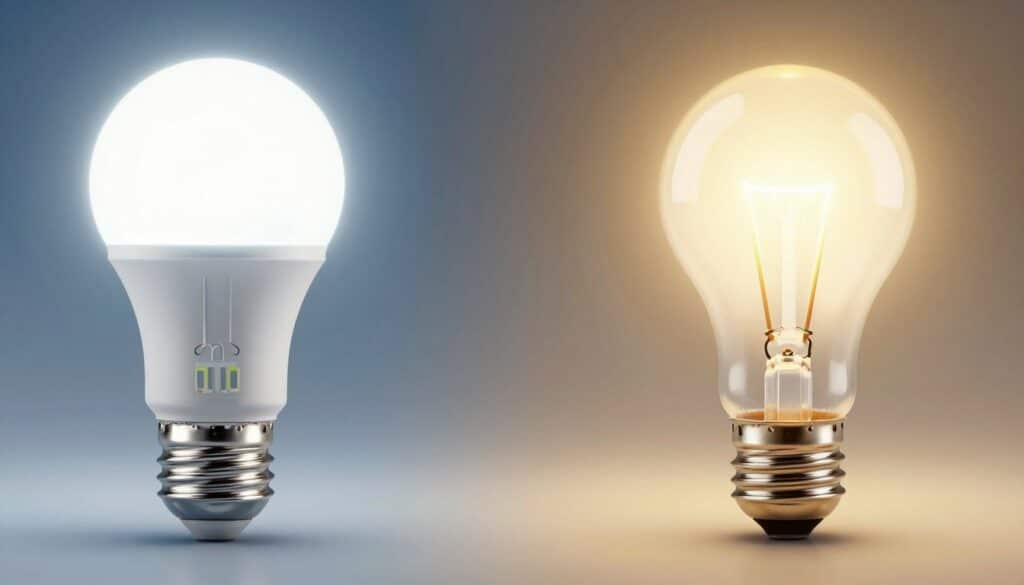
Different Ways of Building Things
Halogen and LED bulbs are made in different ways. LEDs are made of semiconductor materials and are encased in solid plastic or resin. This makes them strong and able to handle shocks. A glass bulb filled with halogen gas holds a fragile filament that makes halogen bulbs work.
You can tell the difference in how long they last and how easy they are to keep up. Halogen bulbs are more fragile and don’t last as long as LEDs, which are more durable and need less care.
To sum up, the main differences between LED and halogen lights are how they work and how they look. These differences have an effect on how well they work, how long they last, and how well they work.
Comparison of Energy Efficiency
The choices we make about lighting affect our wallets and the world around us. Halogen and LED lights use energy in different ways.
Analysis of Power Use
For the same amount of light, LEDs use less power than halogens. They are either brighter or just as bright.
How many watts do you need for the same brightness?
For the same amount of light, halogen bulbs use more watts than LEDs. A halogen light bulb might use 60 watts, while an LED light bulb only uses 9 watts. This means that LEDs use less power.
Calculations for yearly energy use
The amount of energy used each year depends on the wattage and the number of hours it is used. Halogen lights use more energy than LEDs. An LED uses a lot less energy than a halogen when used for 8 hours a day.
Making Heat and Losing Energy
Another thing is that energy is lost as heat. Halogens lose a lot of energy as heat, which is a waste and can cause them to overheat. LEDs don’t lose as much heat, which makes them safer and more efficient.
To sum up, LEDs are better than halogens. They use less energy and make less heat. This is why LEDs are good for the environment and your wallet.
How long it lasts and how long it lasts
You should know how long LED and halogen lights last. This information helps us pick the best lighting options. They are better for the environment and cost less the longer they last.
Average Hours of Operation
LED lights can last for up to 50,000 hours. Halogen lights, on the other hand, last between 2,000 and 4,000 hours. This big difference changes the cost and maintenance of lighting systems over time.
Things That Affect How Long You Live
There are a lot of things that can affect how long halogen and LED lights last. We can get the most out of our lighting by knowing these things.
Effects of Switching Cycles
Halogen lights are more affected by how often you turn them on and off. This doesn’t affect LEDs as much, so they’re better for places where lights are turned on and off a lot.
Durability and Environmental Factors
The life of a light bulb also depends on things like temperature and humidity. LEDs are better at dealing with these conditions, which makes them last longer in tough places.
To sum up, LED lights last longer than halogen lights. In the long run, this makes them a better choice for lighting that is both cheap and good for the environment.
Quality and Performance of Light
To choose between LED and halogen lighting, you need to know how well they work and how good the light is. These things have a big impact on how a space feels and works.
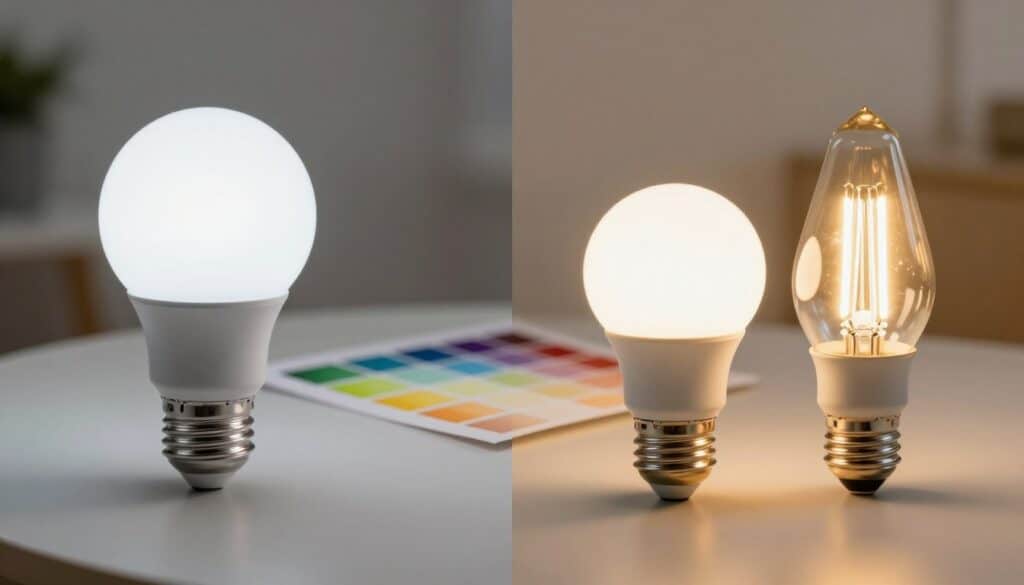
Rendering and Color Temperature
The color temperature, which is measured in Kelvin (K), tells you how warm or cool the light is. LEDs can be warm white (2700K–3000K), cool white (3500K–5000K), or daylight (5000K–6500K).
Getting to know the Kelvin Scale
The Kelvin scale tells you how hot the light is. Light with lower Kelvin values (like 2700K) is warmer and yellower. Light with higher values (like 5000K) is cooler and bluer. You can set LEDs to different color temperatures for different uses, like in homes and businesses.
What is the Color Rendering Index (CRI)?
CRI shows how well a light source shows colors compared to sunlight. Most LEDs have a high CRI, which is usually over 80. This makes them better for places where getting the right color is important. A high CRI makes colors look more real and bright.
Light and Brightness Distribution
Lumens (lm) measure brightness, or luminous flux. LEDs are brighter than halogen bulbs and use less power. Some fixtures are made to direct light well, so they also have better light distribution. This makes the light better and cuts down on waste.
“LED technology has revolutionized the lighting industry by providing energy-efficient solutions with superior light quality and performance.”
In short, LEDs can change color temperatures, have a high CRI, and are bright. For many lighting needs, they are the best choice. Because of how well they work, they are great for both homes and businesses.
Cost Analysis: Short-term vs. Long-term
The first cost isn’t the only thing to think about when choosing between LED and halogen lights. LED lights may be more expensive at first, but they save money over time. This is because they last longer and use less energy.
Comparison of Initial Purchase Prices
At first, LED lights tend to cost more than halogen bulbs. But their prices have gone down, so they are now more similar in cost. To really compare them, you need to look at the cost per lumen.
Calculating the Cost of a Lifetime
When you add up the costs, think about how much energy you use and how long the bulbs last. LED lights are often cheaper over time, even though they cost more at first.
Saving energy over time
LED lights use a lot less power than halogen lights, which can save you a lot of money on your electricity bill. For instance, if you switch 10 halogen bulbs for LEDs, you could save up to $100 a year on your bill, depending on how much you use them.
Things to think about when replacing
LED lights last a lot longer than halogens, so you don’t have to replace them as often. This saves money and makes it easier to keep up with.
| Lighting Type | Initial Cost | Energy Cost (Annual) | Lifespan | Total Cost (5 Years) |
|---|---|---|---|---|
| LED | $50 (for 10 bulbs) | $30 | 50,000 hours | $200 |
| Halogen | $20 (for 10 bulbs) | $100 | 2,000 hours | $520 |
When you think about how much money you save on energy and how few times you have to replace them over five years, the total cost of owning LED lights is much lower.
Impact on the environment
Climate change is a big problem right now, so it’s important to see how lighting affects the environment. It’s important to know the difference between LED and halogen lights if we all want to have less of an effect.
Comparison of Carbon Footprints
Halogen bulbs are not as good for the environment as LED lights. They don’t use as much energy and don’t make as much heat. Halogen bulbs waste a lot of energy as heat, but LEDs make light using semiconductors.
- When it comes to brightness, LEDs use up to 90% less energy than halogen bulbs.
- Making LEDs has become more environmentally friendly, which lowers their carbon footprint even more.
Things to think about when throwing things away and recycling
It also matters how we get rid of lighting products. Halogen bulbs contain harmful substances like mercury and must be thrown away in a certain way. But LEDs are safe and can be recycled, even though recycling them isn’t very common yet.
Important things to think about when throwing away keys:
- You have to throw away halogen bulbs as hazardous waste.
- It’s not common yet, but LEDs can be recycled.
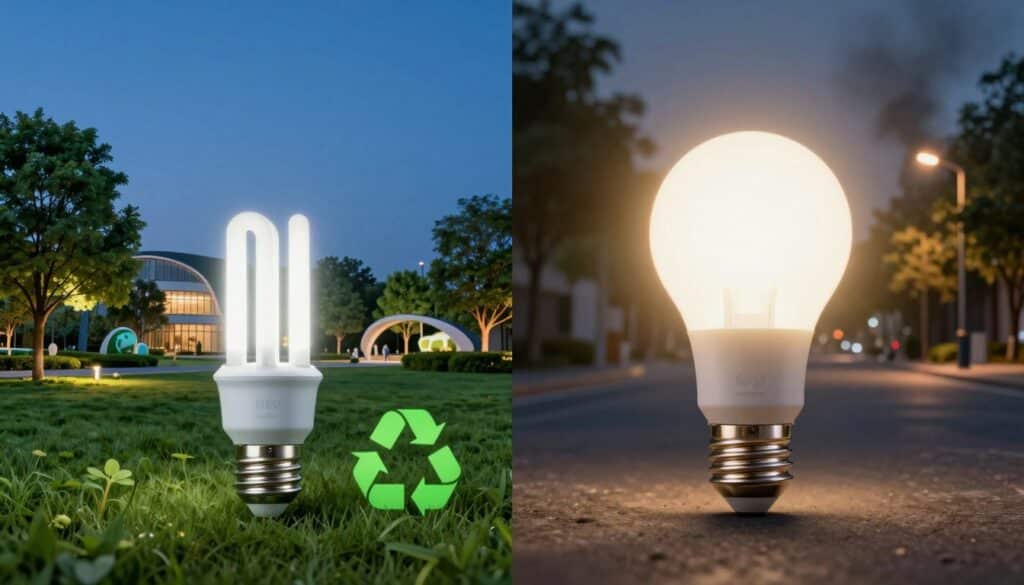
Uses in home lighting
When it comes to lighting your home, it’s important to know the difference between LED and halogen lights. Both have their own uses and advantages in a home.
The best ways to use LED lights in your home
LED lights can be used in many ways. They work well in a lot of parts of the house. They work well in places that need bright, focused light.
Lighting for the Kitchen and Work
LEDs are great for lighting up tasks in the kitchen. They are smart and can be led. They are great for cooking, lighting under cabinets, and countertops. They last a long time and use less energy.
Lighting for the environment and decoration
LEDs are also good for lighting up a room and for decoration. You can change the brightness of these lights. This makes them great for changing the mood in bedrooms and living rooms.
When Halogen Might Be Better
Halogen lights still have their place, even though LEDs have a lot of benefits. Halogen bulbs give off light that is warm and natural. People often think this light is warm and inviting.
| Lighting Type | Ideal Use | Key Benefits |
|---|---|---|
| LED | Task lighting, ambient lighting | Energy efficient, long lifespan |
| Halogen | Accent lighting, decorative lighting | Warm, natural light, dimmable |
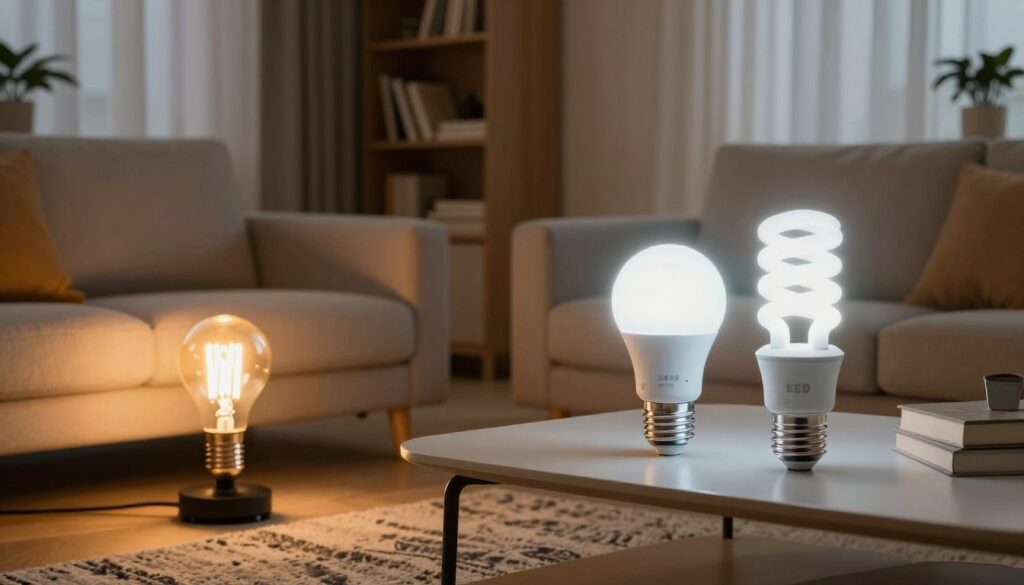
In the end, it all comes down to what you like and need when choosing between LED and halogen lights. If you know what each one does, you can make a lighting plan that works and looks good.
Uses in Business and Industry
More and more businesses and factories are using LED lights. This is because LED lights use less energy and last longer than halogen lights.
Benefits of LEDs in Businesses
LED lights are a big win in business areas. It lowers energy costs, which is better for the environment. LEDs also make the lighting better, which makes rooms look better and feel more inviting.
| Feature | LED Lighting | Halogen Lighting |
|---|---|---|
| Energy Efficiency | High | Low |
| Lifespan | Long (up to 50,000 hours) | Short (around 2,000 hours) |
| Maintenance | Low | High |
Halogen Uses in Certain Industries
Halogen lights still have their place, even though LEDs are better. They are used in industries where specific lighting needs are very important. Halogen lamps, for instance, give off the bright light needed in some factories.
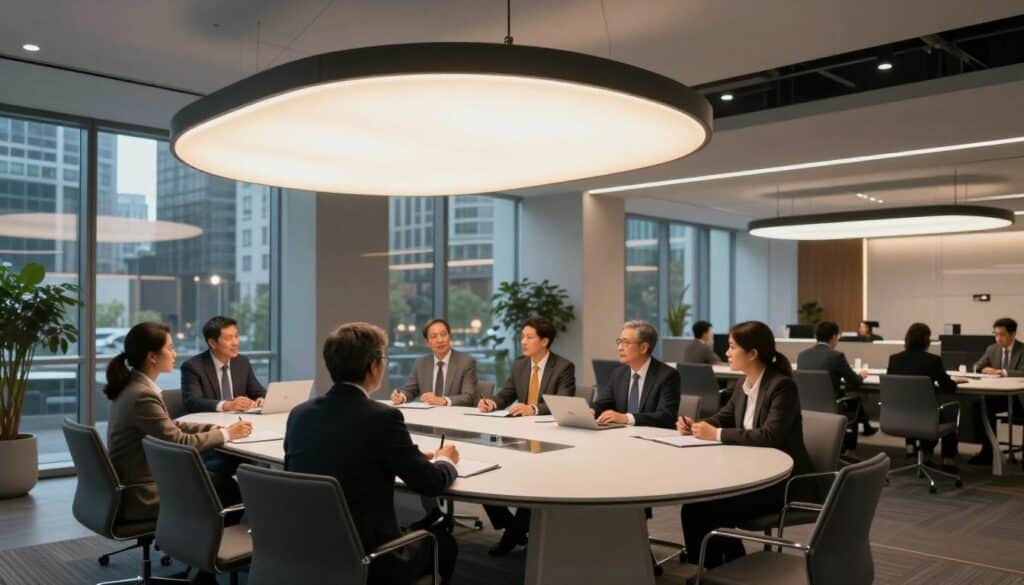
Comparison of Car Lights
LED lights are now used for headlights and signals in modern cars. LEDs last longer, use less energy, and work better, which is why this change is happening. We’ll see how LED lights and halogen lights work in cars.
LED lights and headlights
New cars are starting to come with LED headlights. They are better for the environment and use less energy. Car makers love them because of this.
How well it works in different kinds of weather
LED headlights work well no matter what the weather is like. They don’t stop for rain, fog, or snow. Their high intensity and focused beam cut down on glare, which makes driving safer.
How to make vehicle systems use less energy
Old halogen bulbs use more power than LEDs. They light up the road just as well, but they use less power. This makes cars go farther on a tank of gas and pollute less.
The history and performance of halogen headlamps
Halogen headlights have been around for a long time. Many cars are replacing them with LEDs. But they’re easy to find and cost less up front.
But halogen bulbs don’t last as long and use more power than LEDs. LEDs and other new lighting technologies are becoming more popular in the car world.
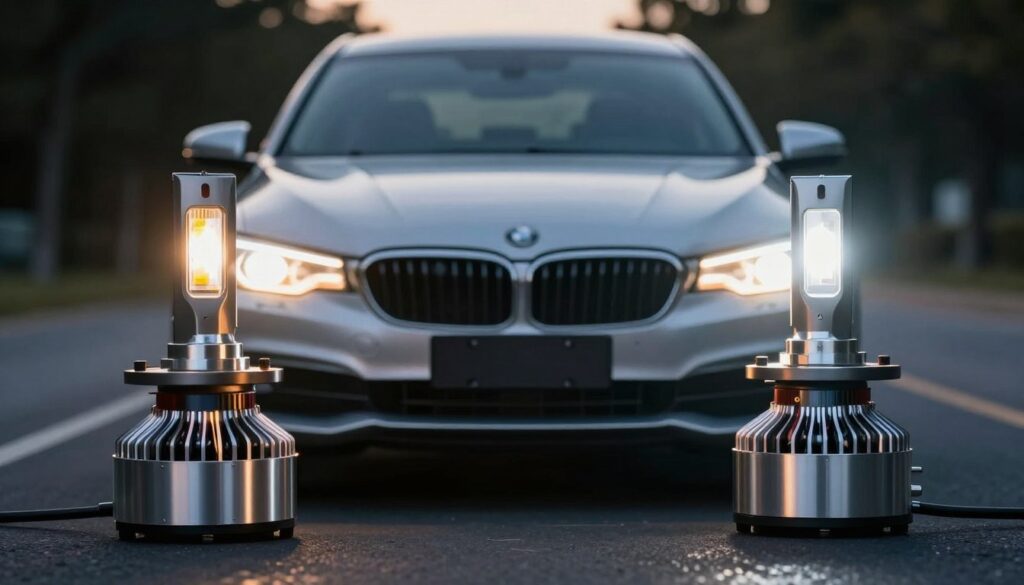
Things to think about for your health and safety
LED and halogen lights are not the same when it comes to health and safety. When making a choice, it’s important to think about how they will affect people’s health and safety.
UV Emissions and Eye Safety
UV radiation is a major health risk. Halogen lights give off a lot of UV rays, which can hurt skin and eyes. LED lights, on the other hand, release very little or no UV radiation. This makes them safer to use for a long time.
“The reduced UV emission from LEDs contributes to a safer lighting environment.”
– Journal of Lighting Research
Risks of Fire and Heat
It’s also important to think about fire hazards and heat-related risks. Halogen bulbs get very hot, which makes it more likely that they will catch fire or burn you, especially in small spaces or near things that can catch fire. LED lights, on the other hand, run cooler and are less likely to catch fire.
In short, LED lights are better for your health and safety than halogen lights. They let out less UV light and are less likely to start a fire.
Trends in Lighting Technology for the Future
Thanks to new ideas, lighting technology is changing quickly. We’re getting closer to lights that are better, greener, and smarter. This change is exciting and big.
New things in LED technology
This change is being led by LEDs. They’re getting better at being smart, saving energy, and showing colors. Smart LED lights can change their color and brightness by themselves. It does this based on the time of day or how bright it is outside. This makes things easier and saves energy.
The Market for Halogen Products Is Shrinking
But there is less and less demand for halogen bulbs. Instead, people and businesses are choosing LEDs. This change is being pushed by rules and the need to protect the planet. In the future, halogen bulbs will be less popular.
Tips for Making the Switch
With the right help, it’s easy to switch from halogen bulbs to LED lights. It’s important to know what to think about for a smooth transition.
Switching from halogen to LED lights
It’s very important to pick the right LED bulb when you switch out halogen ones. LEDs come in different shapes, sizes, and colors. Choose one that works well with the lights you have now.
Picking the Right LED Replacement
When choosing an LED, consider how bright it is (lumens), the color temperature, and whether it will work with your fixture. For instance, if you need to replace a halogen bulb in a recessed light, look for an LED that fits the same socket.
Problems with dimmer compatibility
When you switch to LED, you may have problems with your dimmer switch. Some LEDs can’t be dimmed, and some dimmers may not work with them. Look for LEDs that say “dimmable” on the box and check to see if they work with dimmers.
Problems and solutions with installation
Sometimes it can be hard to install LED bulbs, like when they get too hot or don’t fit right. Follow the manufacturer’s instructions for installing your fixtures and make sure they are LED-friendly.
| Challenge | Solution |
|---|---|
| Dimmer Compatibility | Use dimmable LED bulbs and compatible dimmer switches |
| Overheating | Ensure proper ventilation and use fixtures designed for LED |
With these tips, switching to LED lighting is easy. You’ll enjoy energy savings and longer bulb life.
Conclusion
There are many reasons why LED lights are better than halogen lights. They don’t use as much energy, last longer, and are better for the environment. This is why they are one of the best choices for lighting today.
LED lights stand out as we look for options that are better for the environment and cheaper. They last longer and need less care. This makes them perfect for both homes and businesses.
Getting LED lights is more than just getting a new light. It’s a way to help the world. The future of lighting looks bright and green thanks to new LED technology.
FAQs
What is the main difference between lights that use LEDs and lights that use halogens?
Diodes are used in LED lights to make light. A halogen light has a bulb with a tungsten wire in it.
Do LED lights use less energy than halogen lights?
Yes, LED lights use less energy to be brighter. They also don’t make as much heat.
How long do lights with LEDs and halogens usually last?
LED lights can last as long as 50,000 hours. Halogen lights last for about 2,000 hours.
What effect does using LED lights instead of halogen lights have on the environment?
LED lights are better for the planet. They last longer and use less energy. Halogen lights have dangerous chemicals in them and need to be replaced more often.
Is it possible to switch halogen bulbs for LED bulbs directly?
In many cases, yes, you can replace them. But make sure the LED bulb fits your light fixture well.
Are LED lights good for use outside and in factories?
Yes, LED lights work well outside and in factories. They last a long time and use less energy.
Do LED lights give off UV rays?
Most LED lights don’t give off a lot of UV radiation. This makes them safer for people and things that are sensitive.
What is the difference in light quality between LED and halogen lights?
LED lights are more accurate and have better color. Halogen lights are warmer, but they aren’t as accurate.
What will it cost to switch from halogen to LED lighting?
At first, LED lights cost more. But they save money in the long run because they last longer and use less power.
Are there any health risks that come with using LED or halogen lights?
If they are too bright, both can make your eyes hurt. Halogen lights can get very hot and start a fire.
What does the future hold for LED and halogen lights?
LED technology is getting better, with more colors and better efficiency. People are using halogens less and less as LED prices go down.
